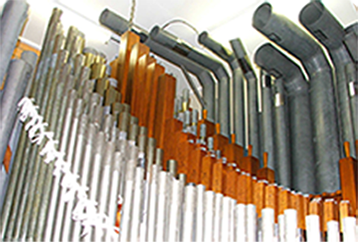Most of us know that a Theatre Pipe Organ works by having wind from an electric blower pass through organ pipes which are actuated by selecting stop tabs, and then playing keys on the keyboards/pedalboard. But for those of us who have never experienced playing at the console, or who have never examined the inner workings of one of these complex instruments, some of the parts we read about can be a mystery. We have thus compiled some brief definitions of typical organ components:
The organ console:
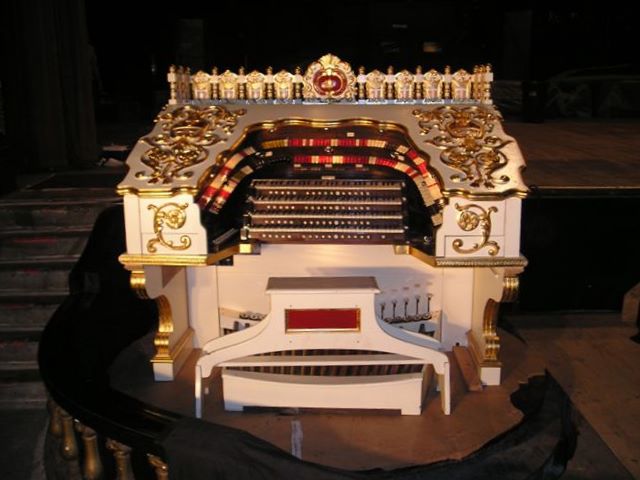
A Robert Morton brand “Wedding Cake” Design 4 Manual Console with Gold Ormolu Decorations and Dogleg Bench
Console – The command center of the instrument. Shaped like an oversized upright piano it contains multiple keyboards, a pedalboard, and a myriad of switches and controls. The console cabinet can vary from plain stained wood to an elaborately carved, decorated and painted work of art. Many times consoles were embellished to match the décor of the theatre in which they were housed.
Gold Ormolu -- Raised wood carvings. They are either painted gold or gold leafed and are typically applied to a white or natural stained wood console cabinet.
Dogleg Style Bench – The bench for the artist to sit on while playing. The shape is unique to Theatre Organs. Viewed from the back, the feet of the bench straddle the pedalboard, and curved “dogleg” shaped members rise up to support a flat narrow seat. (Classical/church organs generally have a rectangular shaped bench with the seat as wide as the feet).
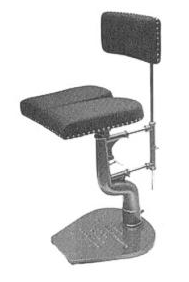
Howard Seat -- A special organ seat, in lieu of a bench, produced by the E.R. Howard Company of Dubuque, Iowa back in the 1920’s. A large metal base is slipped beneath the back of the pedalboard. From it rises a curved tubular support capped by a padded two piece seat with backrest. The seat is hinged at the back (the side facing the audience). The artist’s thighs rest on the two halves which open and close as he/she reaches right and left to play notes on the pedalboard. A number of artists purchased their own Howard Seats and took them wherever they played. Famous organist Jesse Crawford was an advocate of the seat. Some other male artists shunned their use due to the obvious danger to the male anatomy whenever the two halves of the seat came together!
AGO Specifications – In the 1930’s, in an effort to standardize organ consoles, the American Guild of Organists (The national classical/church organ group) published dimensional specifications for virtually every aspect of organ console construction. Any organ boasting AGO specifications must adhere to these standards. Unfortunately, this standardization came after the heyday of the Theatre Pipe Organ in the 1920’s, and vintage Theatre Organs can and do vary by manufacturer and by instrument. Where this does cause a problem is in pedalboard construction. Performers who are used to playing a particular instrument can find themselves missing their pedal notes when they try to play an instrument with a slightly different pedalboard configuration.
Manuals – The 61 note organ keyboards, played by the hands. Think “manual dexterity”. Organ keys have a receding front, allowing them to overhang the manual below (As opposed to piano keys, which have a flat front). The bottom manual is generally installed flat. The rest of the manuals tilt forward toward the performer, each successive keyboard having a more pronounced tilt. Vintage wooden keys from the 1920’s were covered with ivory. Today, modern keyboards utilize plastic coverings.

Note the tilt and overhang of the 3 manuals
Key Cheeks – The wooden members which frame the keyboards at each end.
Pedalboard – The 32 note keyboard consisting of pedals played by the feet. The pedals radiate. That is, if you drew straight lines along the centers of all 32 pedals, they would meet at a common point (from which they radiate), somewhere behind the performer. The pedalboard is also concave. That is, the pedals are installed on an arc with the lowest pedal in the middle of the console and the highest pedals at either side. This accommodates the natural swing of the leg, as the artist plays.

32 Note AGO Pedalboard, viewed from above.
Stops/Stop Tabs – The colorful plastic (originally celluloid) switches shaped like tablets which are spaced around the horseshoe shaped console. They enable the organist to select different ranks of pipes (flute, violin, diapason, etc) and their low to high pitches (32’, 16’, 8’, 4’, etc.) . The nomenclature “stop” comes from the act of stopping (or starting) the flow of air to a particular set of pipes. The term originated with the classical/church organ where draw knobs are pushed in to stop the flow of air, and pulled out to start it.

Wurlitzer Stop Tabs positioned along Double Bolster Stoprails and Backrail
Each manual and the Pedalboard are assigned their own set of stop tabs The standard layout of stop tabs around the horseshoe on Theatre Organs, moving from left to right is generally from bottom to top keyboards. First Pedal stops, then Accompaniment Manual stops (bottom manual), then Great Manual stops (next highest manual), etc.
In addition, stop tablets are used to control organ functions such as turning tremulants on and off or activating couplers or second touch stops.
Bolster or Stop Rail - The face board which contains the stop tabs. A straight bolster can run straight across the console above the uppermost keyboard, and is also referred to as the “backrail”. Most stop tabs, however, are located along the horseshoe shaped bolster or stop rail. A console with two rows of tabs around the horseshoe is said to have a “double bolster”. On some consoles there are markings along the stop rail above each stop. This is a code to indicate in which organ chamber the rank of pipes is located.
Registration -- The combination of sounds selected by the artist for a particular song or part of a song. The pedalboard and each manual is “registered” by selecting appropriate stops which blend with each other to make the full ensemble, or the solo voice desired. There are 4 families of pipes in a Theatre Organ: Tibia/Flute, String, Diapason, and Reed.
Pistons/Combination Action -- The round pushbutton switches located beneath each keyboard are called “pistons”. They are also sometimes available as “toe studs” or foot switches located above the pedals. Piston switches operate the combination action which allows the organist to preregister “combinations” of stop tabs, and then replicate each combination simply by pushing a piston button, or a toe stud. When a piston is selected, the stop tabs physically move to the on (down) or off (up) position, so the organist can see what ranks are playing. “General” pistons control combinations of stops on all keyboards and pedalboard at once. They are usually found at the left end of the keyboards. “Individual” pistons are usually found at the center or right end of the keyboards below the manual they control. They operate only one keyboard, but there is one exception. The “individual” pistons for the lowest manual (accompaniment manual) usually also control registration of the pedal at the same time.
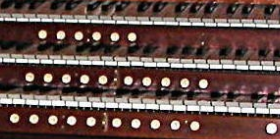
Pistons located beneath the Manuals
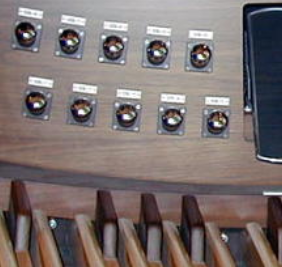
Toe Studs
General Cancel (GC) – A piston which cancels all previously selected combinations. Used to turn off all stop tabs at once. (Hit this by accident while you are playing, and all sound ceases!)
Sforzando – A piston which when pressed, gives the artist “full organ” with virtually everything playing. In classical organs called “tutti”.
Sostenuto Switch – “Look ma, no hands!” A switch on the console enabling the artist to remove his/her hands from the keyboards while the last notes and chords played are sustained (continued). This enables the artist to play counterpoint to the sustained notes.
2nd Touch – An organ keyboard which is pressure sensitive is said to have “second touch”. Press lightly on the keys as you play, and the registration you have selected will sound. Press harder on the keys and additional “2nd Touch” stops which you have also selected will be added to the sound. Organs which have 2nd touch available on a particular manual will also have special stop tabs for the available 2nd touch ranks for that manual.
Expression Pedals or Swell Shoes – The volume controls of the instrument. These are the large rectangular pedals in the center of the console above the Pedalboard. Each organ chamber can have its own expression pedal. Pressing down on the pedal with your toes opens the shutters in front of the chamber allowing more sound to escape into the listening space. The more the expression pedal is pressed, the greater the volume. Pulling back on the pedal with your heel closes the shutters and decreases the volume. The term “Swell shoe” is more frequently used with classical instruments. The term “Under Expression” means that ranks of pipes are housed in a chamber with their expression (volume) controlled by an Expression Pedal at the console. In some installations, ranks of pipes and percussion instruments are installed directly in the listening space. Their volume level is thus fixed and they are not “Under Expression”. Divided Expression means that each organ chamber is controlled by a separate pedal. (Some smaller organs only have one expression pedal controlling both chambers).
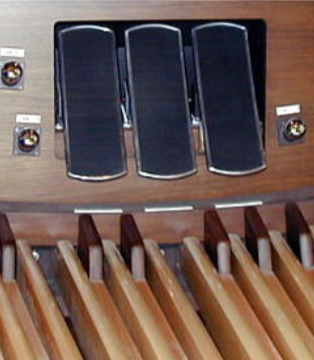
Two Expression Pedals on the Left, Crescendo Pedal on the Right
Crescendo Pedal – The rightmost rectangular pedal, next to the Expression Pedals. Pressing on the pedal with the toes enables the artist to add a “crescendo” of sound as more and more ranks of pipes are automatically added to the sound already selected. Pressing all the way down gives full organ. Pulling back with the heel removes ranks from the sound.






